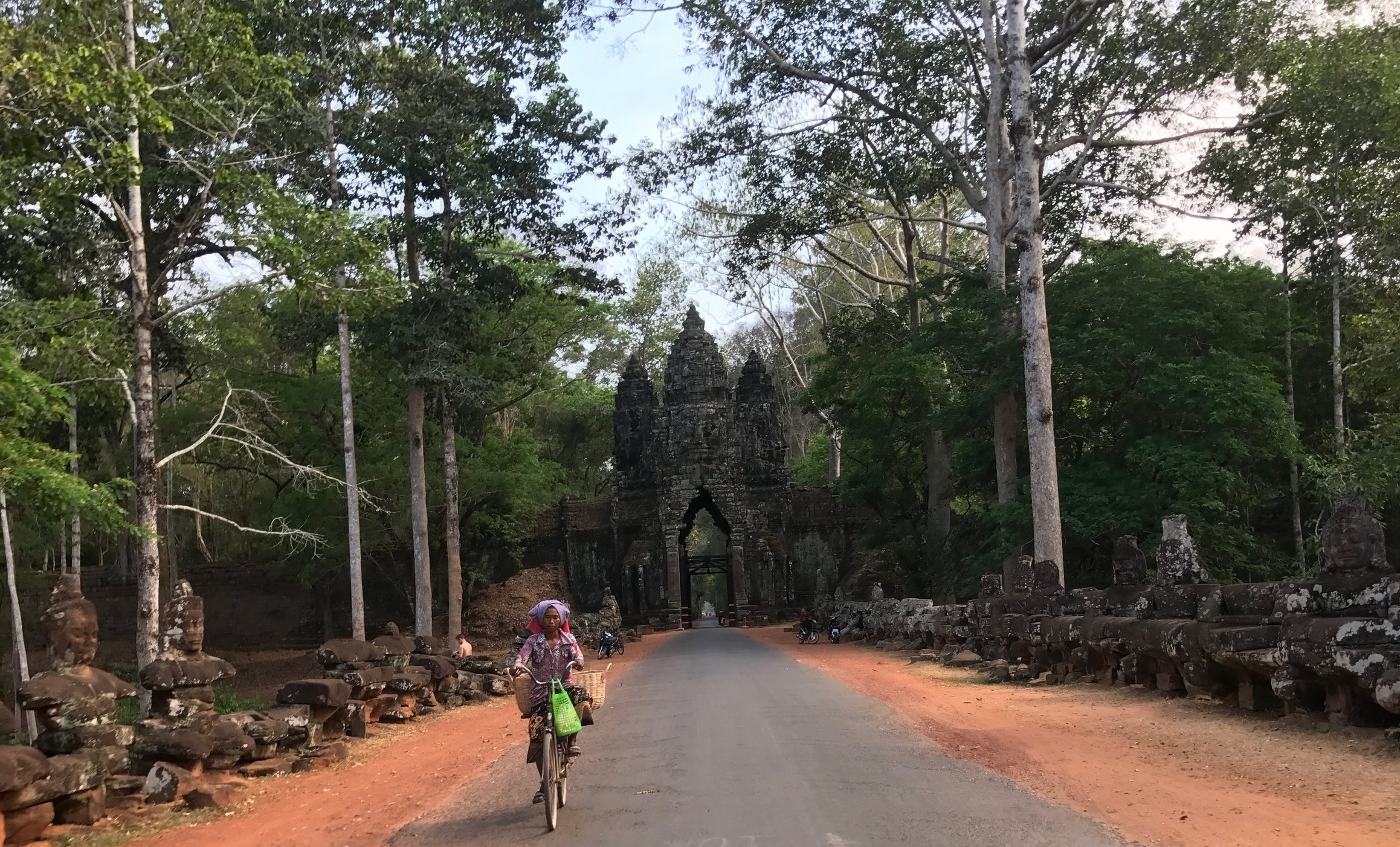Siem Reap
On the outskirts of Siem Reap, Cambodia, lies Angkor Archeological Park, home to the relics of the Khmer Empire’s once thriving ancient city consisting of hundreds of temples spread across 154 square miles of jungle and farmland.
Angkor was the capital of the Khmer Empire, which thrived from the 9th to 15th centuries, and may have supported over 1 million people. UNESCO declared the archeological park a World Heritage site in 1992, and considers the remnants of this once great civilization to be one of the most important archeological sites in Southeast Asia.
For many Cambodians and Buddhists, the temples remain sacred places of worship, but no matter your faith, these relics will move you with their undeniable soul.
Here’s what it’s like to visit. (Click on the headers below for a detailed review of each temple.)
RECAP: GETTING THERE, RULES & REGULATIONS, WHAT TO BRING
Visa On Arrival – Many foreign travelers will need to obtain a Visa On Arrival when traveling to Cambodia. No prep work or applications needed. Simply fill out the appropriate form at your port of arrival, wait in line, have your passport stamped by an immigrations agent, and carry on your way.
USD is the Official Tourist Currency – USD is the expected cash currency at all sites, restaurants, hotels, etc. Only fresh, unmarked and recently issued bills are accepted.
Dress Code – The temples are active places of worship, requiring respectful and appropriate garb. Women and men are expected to cover their shoulders, and legs should be concealed past the knee.
Get Your Pass – Passes can be obtained at the main archeological museum for 1, 3, and 7 days. Pass purchases are cash only with fresh US notes. Proper attire is required. The pass is a photo ID that you will have to present at each temple entry point, and it will be stamped each day it’s used.
Tuk Tuk’s – Hiring a tuk tuk driver to take you to the sites near Siem Reap costs about $20/day. With this fee you are hiring a private driver to wait for you at each site and take you to your next destination. Tuk Tuk’s to further destinations, like Banteay Srei and Kbal Spean, will cost about $40/day. Check with your driver in advance.
Biking – You can bike to Angkor Wat from Siem Reap and the surrounding area, but keep in mind the possibility for extreme heat, and that you’ll be required to bike through downtown Siem Reap to get there.
What to Bring - Sunscreen, your pass, water, camera, snacks, handkerchief, hat or parasol, US cash (small bills a plus).
Tour Guides – Tour guides can be very helpful if you’d like to dive into the history at each site. If you only have the cash to spring for a guide once, we recommend doing so at Angkor Wat or Angkor Thom to get the most bang for your buck. Look for guides from the tourism department. They’ll be in uniform with official tourism patches and badges. A two-hour tour at Angkor Wat costs about $15, plus tip.
We purchased a 3-day pass, which was good for 10 days, allowing us to spread our tour over a week, giving us plenty of time to rest up in between our temple days. If you have the time to spare, we recommend this approach. Visiting the sites is incredible, and exhausting. Make sure to hydrate and relax in between!
DAY 1: ANGKOR WAT AND TA PROHM
Angkor Wat
Angkor Wat, meaning ‘temple city’ is the main attraction at Angkor Archeological Park. Built in the 12th century by Suryavarman II as the king’s state temple and capital city, Angkor Wat, which was originally dedicated to the Hindu god, Vishnu, was transformed into a Buddhist temple in the 14th century, and remains an internationally relevant Buddhist site today. When the Khmer Empire left Angkor in the 15th century to build a new capital, Angkor Wat remained one of the only temples that was never fully abandoned. Historians believe this is the reason it has remained so intact. Its large moat added further protection by prohibiting the jungle from reclaiming it. French explorer Henri Mouhot introduced the site to westerners in the mid-1800s.
Ta Prohm
Ta Prohm has been left much in the condition in which it was found by westerners in the 1800s, and is one of Angkor’s most famous jungle temples. Overgrown with enormous trees, the temple has largely merged with nature making it a mystical sight to behold. Built in the late 12th and early 13th centuries under King Jayavarman VII as a Buddhist monastery and university, the temple was famously brought back into the spotlight by the 2001 film Tomb Raider.
DAY 2: ANGKOR THOM AND PREAH KHAN
Angkor Thom
After Suryavarman II’s death and the ransacking of Angkor Wat by Khmer enemies, King Jayavarman VII moved the capital to Angkor Thom in the 12th century where under his reign the present day ruins were built on the same site as a former Khmer capital. Angkor Thom houses the famous and widely recognizable Bayon temple, or temple of 1,000 faces, featuring over 200 gigantic blissful faces topping 37 towers. The old city is also home to the royal palace, the temples Baphuon and Phimeanakas, the Elephant Terrace, and the Terrace of the Leper King. This walled city is believed to have supported 80,000 – 150,000 people at its height.
Preah Khan
Like Ta Prohm, the jungle is steadily re-claiming Preah Khan, and features incredible feats of crumbling temples supporting the growth of enormous trees with roots that have become part of their foundations. Built in the 12th century under King Jayavarman VII to honor his father, the site was a combination of city, temple and Buddhist university serving as a hub for nearly 100,000 officials and servants, including 1,000 teachers and another 1,000 dancers. The temple is built on the site of Jayavarman’s victory against the invading Chams in 1191. It’s modern name, adapted from the original, means ‘holy sword.’
Surrounded by a moat, the temple is built in a flat style with successive rectangular galleries gathering around a central Buddhist sanctuary. Like it’s neighbor, Ta Prohm, it has been largely unrestored, allowing the jungle to slowly overtake it.
DAY 3: BANTEAY SREI, KBAL SPEAN, AND PRE RUP
Banteay Srei
Built from striking red sandstone and lined with well-preserved intricate and elaborate carvings, Banteay Srei is unlike any other temple in Angkor Wat Archeological Park. Located 16 miles northeast of the main Park, visiting Banteay Srei and its surrounding sites is a worthy commitment.
Known colloquially as The Pink Lady Temple and The Lady Temple, Bateay Srei is a 10th century temple dedicated to the Hindu god Shiva and is the only major Angkorian temple that was not built by a monarch. It is most famous for its color, its small size, and equally miniature yet mightily impressive artwork.
Kbal Spean
A jungle trek into the Kulen Hills will lead you to Kbal Spean: an archeological site of river carvings leading to a sacred waterfall. The site’s famous reliefs were carved by hermits into the naturally formed sandstone of the riverbed and its banks between the 11th and 12th centuries under the reign of King Suryavarman I, and King Udayadityavarman II. The site is also known as the ‘valley of 1000 lingas,’ and the ‘river of a thousand lingas,’ for the many lingas carved there (lingas are the phallic symbol representing the Hindu god Shiva). The Siem Reap River, which flows over the sacred lingas into Angkor, was believed to bless the city. Many other Hindu gods are also featured in the carvings. When the water table is low, the carvings are visible in a 150-meter section of the river in the middle of which is a naturally formed sandstone bridge. They stretch to a waterfall where visitors can bathe and be blessed beneath its spring.
Pre Rup
Overlooking the countryside and surrounding jungle, Pre Rup glows with a lovely reddish hue in the hours near sunrise and sunset due to its brick, laterite and sandstone construction. Aligned with a north south axis, this temple is dedicated to the Hindu god, Shiva. Locally believed to have been a mortuary, Pre Rup was built as a state temple under King Rajendravarman in the 10th century in the temple mountain style that is characteristic of many of the Angkorian sites.
GOOD TO KNOW
Handling Solicitation – The moment your tuk tuk arrives at any location expect to be approached by men, women and children looking to sell you anything from pants to guide books, postcards and trinkets before your driver can even park. When inside the sites, you may meet locals asking for donations, and encounter park staff or even police officers that will offer to take your photo in exchange for a ‘tip.’ The best way to handle these situations is a simple, brisk and sometimes repeated no thank you.
Temple Fatigue is Real – There is so much to see at Angkor Wat that it could easily take a month to dive into all the details of each of these ruins. Don’t try to do it all. Rest when you need to and call it a day when you’re ready. Though many people begin their tour at Angkor Wat as early as sunrise and trudge through the rest of the day in the heat, we opted to start between 8 and 9AM and wrap up by closing, which was perfect for us. The amount to see can be over-stimulating. We recommend taking time to just sit and be in those spaces, really commune with it. You may see a little less, but you’ll likely feel more. Pro Tip: We visited in March, one of the hottest times of the year, and noticed that the heat of the afternoon drove away much of the masses allowing us to enjoy several temples with very few other visitors. A real treat!
ENJOY YOUR VISIT!
These are the kinds of places that stir the heart and the imagination, that strike us not only with their awesome beauty and gateway to spirituality, but with their undeniable humanity that gives us pause by daring us to look at ourselves, where we’ve come from, where we are, and where we are headed as a global people.

























































































































